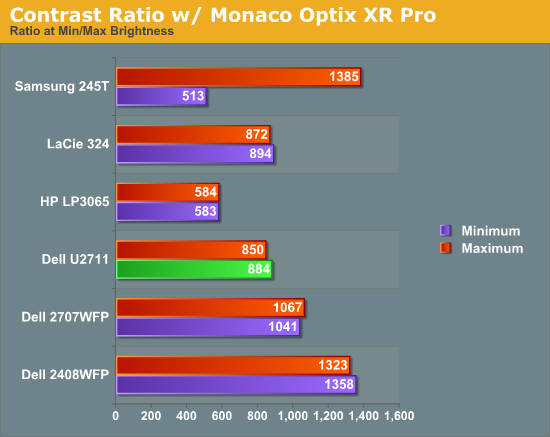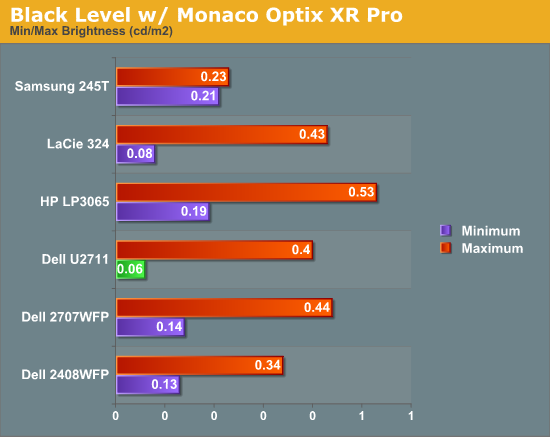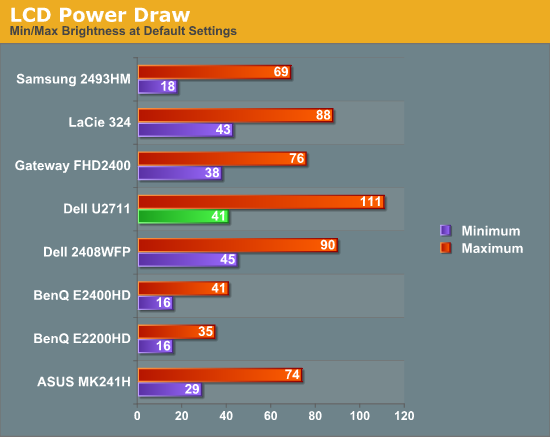Dell UltraSharp U2711: Quality has a Price
by Jarred Walton on January 22, 2010 2:00 AM EST- Posted in
- Displays
Brightness and Contrast
For the brightness, contrast, and color accuracy tests, we depend on a hardware colorimeter and software to help calibrate the displays. We use a Monaco Optix XR (DTP-94) colorimeter and Monaco Optix XR Pro software. Dell advertises a typical contrast ratio of 1000:1 and a maximum contrast (using dynamic backlight adjustment) of 80000:1. We're not interested in dynamic contrast, so we used the Adobe RGB setting for the results below. For those that are wondering, the reason we don't like dynamic contrast is that CCFL backlights take time to settle in and provide a consistent output, and if a display is constantly modifying the backlight level you won't get accurate colors.



Don't pay too much attention to the white/black graphs, as they are merely reference points for how the displays perform at certain settings. Like many other LCDs, the U2711 has a "normal" brightness level of around 260nits (the Adobe RBS setting defaults to 50% brightness and contrast), which is more than sufficient and is actually brighter than what most users prefer to use in an office environment. You can reach the advertised 350nits (give or take) if you max out brightness and contrast.
We're more interested in the contrast ratio, and here we find that the U2711 doesn't quite reach the advertised 1000:1 but instead comes closer to 850:1. We would have liked to see black levels a bit lower to improve the contrast, but really anywhere above 750:1 is difficult to see the difference, and 500:1 is sufficient for most users. At lower brightness settings, the contrast ratio improves to the point where our 100nits "print" result (~13% brightness) actually reached the advertised 1000:1 contrast ratio.
Power Requirements
Going along with the brightness levels, here are the power requirements we measured at the Windows desktop using the minimum brightness (53nits) setting along with 100nits (13%), 200nits (36%), and maximum brightness (340nits).

This is another area where we think the U2711 could be improved, but the cost might be too high right now. CCFL backlighting has been the norm since LCDs first came out, and it works but it's not the most power efficient way of lighting up an LCD. LEDs are the new and improved method, but while they can save power they also tend to deliver a lower color gamut. RGB LEDs address that shortcoming but they cost more and appear to use a similar amount of power compared to CCFL (and we've only seen them used in laptops so far). The U2711 draws a minimum of 41W, but a more realistic setting of 200nits will pull 72W. At maximum brightness the display settles down to 111W, but we measured a peak draw of 124W. (When we first cranked up brightness from 36% to 100%, brightness also reached 390nits before declining to 340nits.) We'd like to see LCDs that deliver all the color quality at half the power draw, but right now it's more a question of priorities: if you go green on power, your green colors may end up lacking. And to keep things in perspective, 72W at 200nits for a 27" LCD is still about half the power of your typical 21/22" CRT running at ~200nits!










153 Comments
View All Comments
JarredWalton - Monday, January 25, 2010 - link
I've also tested with the i1 Display2 and achieved essentially the same results (within about 10% on Delta E and within about 2% on gamut). I'm not sure if the Spyder3 is better than both of those, but the i1D2 is pretty well regarded and I've read some stuff in the past where DTP-94 was regarded as one of the better colorimeters. I may play around with the latest version of ColorEyes again just to make sure nothing is wrong. I really don't want to have to invest in another colorimeter, though, since I already have three. :| It would be particularly odd for Spyder3 to be better considering Spyder2 wasn't regarded as being all that great and Spyder3 costs around half as much as the i1D2 or DTP94. But hey, price isn't necessarily a good indicator of quality. Heh.toyotabedzrock - Monday, January 25, 2010 - link
Any chance we will see a review on the U2410? I have heard of problems with it and would like to see your take on it.AngEviL - Sunday, January 24, 2010 - link
Hi Jared, can you please answer me this question ? I had a 22"1680x1050 monitor and I was very annoyed by the "sieve effect". Basically i saw the blackness between the pixels. For that reason mostly i upgraded to a 24" 1920x1200 TN panel lcd and i still spot very well the black between pixels and it is annoying me. Now you will ask how far i am standing from the monitor. I am at 2 thirds of a meter away, or 2 feet, and i really can't go any farther than that because the monitor becomes too small in my field of view.I know that the lower pixel pith will make the blackness between pixels less noticeable, but my question is how much less ? Also, is the proportional distance between pixels smaller compared to other models ? I'm just making this up, but let's say that on a 24" 1920x1200 monitor 90% of the screen space is pixels, and 10% is the black space between them. Does this Dell have less black space proportionally or it maintains the same ration, like 5% black space ?
I ask because i know that the "sieve effect" will be less noticeable on this Dell because of the lower pixel pitch... but how much less compared to a 24" 1920x1200 TN panel ? Thanks.
AngEviL - Sunday, January 24, 2010 - link
In case you think that the monitor i have has larger pixel spacing or something, i do see this sieve effect just as much on my 1440x900 17" laptop (from a normal viewing distance), and on my friend's laptops, as well and it is bothering me as much. Another reason why i ask is because i read somewhere that H-ISP (which i think this panel uses) has less proportional distance between pixels(more space is used up by the actual pixels and less by the blackness between them). I'm wondering if this is really true.JarredWalton - Monday, January 25, 2010 - link
You have better eyes than me, certainly. I can say on the U2711 (and on 30" LCDs), I really can't spot the red green and blue elements that make up white unless I get out a magnifying glass, and I certainly can't see the black between those elements. Well, I suppose I sort of can see the squares that make up the LCD, but that's about it. The U2711 is certainly smaller dots than other desktop LCDs, though.AngEviL - Monday, January 25, 2010 - link
Thanks for the answer.macforth - Monday, January 25, 2010 - link
An interesting article Jarrad. Clearly from the derth of discussion, screens are very important to us all. Although I don't feel that old, and enjoy gaming to the max, I clearly remember the days when there was no such thing as a visual display unit (as we called them when they were first used).Since those heady days in the late 60's we have sure come a long way from those green screens to that which is the subject of your article.
Surprisingly, having read all the post article discussion, no mention has been made of the new 120Hz screens. You did mention 60Hz at one point in the discussion.
I just built a nice gaming PC for a mate, and bought a new 120Hz screen to go with that. All I can say, it beats all the other screens in the house from 30" to 22" to an old 21CRT.......mind you when the CRT was in it's hayday, maybe similar. It is very impressive, and was nowhere near the cost of the sceen in your article.
I do hope that you, or maybe your (hopefully) new writer can have a crack at the new 120Hz movement in screens. Oh!.......the ones available round me (downunder) are 16:10, lol
Keep up the good work!.......
JarredWalton - Monday, January 25, 2010 - link
The big complaint with 120Hz displays is that they're all TN panels (as far as I'm aware). But, TN is often good enough for a lot of people, and it's a lot cheaper than IPS and *VA. I'm hoping to at least get *some* 120Hz LCD for testing in the not-too-distant future.mikeyakame - Sunday, January 24, 2010 - link
I couldn't find the panel type mentioned anywhere, but from what I recall this and the Apple 27" monitors both use the new LG-Phillips 27" H-IPS Panel, not S-IPS.JarredWalton - Sunday, January 24, 2010 - link
I couldn't get any report of the manufacturer; I used to get decent results from Astra32, but now the manufacturers have gotten smart and Dell writes their own name in the firmware. So this panel tells me it's a "Dell U2711". LOL.I don't think I called it an "S-IPS" anywhere; it's just *some* form of IPS, and whether that's H-IPS or S-IPS isn't hugely important. Given contrast is measured at 800:1 to 1000:1 (depending on brightness), H-IPS is entirely possible. But then, refinements to LG's S-IPS might accomplish the same thing.